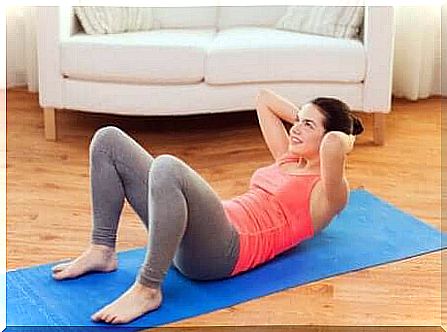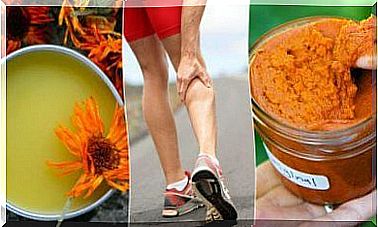Sit-ups Without Back Pain: Here’s How!
It can often happen that you do sit-ups and then have back pain afterwards. To prevent this from happening and to train the abdominal muscles properly, two things are particularly important: proper breathing and a protective pad for your back. You can find out what else we recommend in this article.

Just like you, many want to train their abdominal muscles with sit-ups. But what is that exactly?
In short, the abdominal muscles are the skeletal muscles located on the abdominal wall and in the deep abdominal region. A distinction is made between anterior, posterior and lateral abdominal wall muscles. Other names can also be found. For example, they are divided into deep and superficial abdominal muscles, among other things.
The abdominal muscles are responsible for stabilizing the body and for your posture. Likewise for the protection of the internal organs and so on.
Exercises to train the abdominal muscles are very fashionable these days, and not necessarily only for health reasons, but often also for aesthetic reasons. Because who wouldn’t want a flat and firm stomach? But many do not know how to properly perform the appropriate exercises, such as sit-ups.
As a result, they often have back pain after training, especially in the lumbar region. That is why in this article we explain some very simple tricks. With it you can train your abs without affecting your back.
First step: Make sure you are breathing properly when doing sit-ups
In order to properly exercise sit-ups and strengthen your abdominal muscles in a healthy way, it is important to: Always be careful of your breathing. Because a common mistake is to hold your breath while doing the exercises. But that shouldn’t happen. It is recommended, however, that you breathe in while tensing your abdominal muscles and then exhaling as you relax your muscles. It is also advisable to gradually let the air out through your mouth as you breathe out.
If, on the other hand, you hold your breath, the following happens: You increase the pressure in the abdomen by tightening the diaphragm. In addition to the tension created by the sit-ups, this pressure can become too strong. This can even lead to an inguinal hernia.
The lumbar region also deserves special attention during sit-ups

Lower back pain is one of the most common complaints in the adult population. This is mainly due to today’s lifestyle. The two main factors are these: The majority of people sit far too much. It is precisely because of this that many have very bad postures. However, appropriate sporting exercises can help against this. But to do this, of course, you have to do it correctly. Otherwise, it can make the problem worse instead of helping to strengthen that area.
So it is necessary that you pay special attention to the lumbar area during sit-ups. First of all, it is ideal to use a mat for the exercises. Because that way you can protect your back better. You should also make sure that your entire back does not lose contact with the mat during exercises that involve raising your legs. To do this, you can put your hands under your buttocks to help. This can make it easier for you to have your back resting on the mat during the exercise.
But if you have general problems in the lumbar area, it is advisable to replace the classic abdominal muscle exercises with other exercises. For example, you can do push-ups or, as an alternative, you can do hypopressive exercises. These are more of a static exercise. These improve both the tone of the lumbar and abdominal muscles without putting too much strain on the spine.
Do sit-ups without straining your neck
In typical sit-ups, you first lie on your back with your knees slightly bent and then lift your upper body towards your knees. This very often results in tension in the neck and throat. Because when you try to lift your upper body, you usually make a lot of effort with your neck, throat or back. And that can then lead to problems and discomfort in the cervical spine area.
So you should try to avoid this. It is important that you only draw strength from the abdominal muscles during the sit-ups. To help you do this, you can cross your hands behind your neck. However, without pulling the upper body up with them. If you already have problems in the neck area in general, the following is best: Then you do the exercises to strengthen the abdominal muscles with your legs only and let your head rest on the floor.
More abdominal muscle exercises that are easy on the back
As we mentioned earlier, the typical ab exercises are sit-ups and the like. So those in which you lie on your back and lift your upper body. But there are many other ways to train your abs. Many are actually much less stressful for the back and neck.
For example, you can also train your abdominal muscles with push-ups. Pushups work like this: You lie face down on your exercise mat. Then you lean on your forearms and toes. Your body should form a straight line. So your buttocks shouldn’t be too high or too low.
You can do several sets of exercises lasting 30 seconds or one minute. You can also have fun with variations during the push-ups. For example, you can alternately lift one leg.
You can also try side push-ups. To do this, first lie on one side with one leg on the other. Then you prop yourself up on your forearm and lift your hips. Again, your body should form a straight line. If you want, you can raise your other arm up. In this way you can train the lateral abdominal muscles very well.
Conclusion
So if you would like to have a flat and firm stomach and also want to do something for your posture, then you can do various abdominal muscle exercises. But you should keep the tips from this article in mind: On the one hand, pay attention to your breathing and pull the strength from your abdominal muscles during sit-ups. Because that’s how you can protect your back. In this way you avoid injuries to the lumbar and cervical spine and train your abdominal muscles more efficiently.









